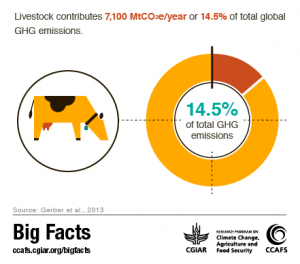The relationship between greenhouse gas (GHG) emission and agricultural.
Greenhouse gases includes: nitrous oxide(N2O), carbon dioxide(CO2), methane(CH4), water vapor (H2O)
Our daily consumption requires many processes that lead to GHG emissions such as : agriculture production, food processing, transportation and storage, cooking and kitchen waste disposal. It’s been calculated that 24% of the total world GHG emission is contributed by agricultural. Food consumption increases lead to increase of GHG. Since animal food production contributes to the highest GHG emission in agriculture, by switch our diet to more plant-based will help to fight climate change.

The pathway of agriculture contributes to the GHG emission, such as land-use change, livestock, crop, burning.(source: IPCC)
Our diet choices are tightly related to climate change.

The percentage and amount that livestock contributed to the total agriculture GHG emission.(source: Big Facts)
The diet of western countries is more protein based diet, which means that people will consume more livestock products, such as milk, beef, cheese and so on. However, among all of the food, livestock contributed the highest GHG emission, it takes 14.5% of the total world GHG emission. A kilogram of beef can emit 34.6 kilograms of CO2, which is much more higher than that of the same amount of plant-based food, which emits less them 0.2 kilograms of CO2 per kilogram of the production. The livestock system contributes to the GHG emission by emitting the CO2 from the land use changing. Also, the N2O will be emitted from the manure treatment and animal digest process, which releases CH4. Additionally, the feeding of livestock will need more landfill with the increasing of the food production so there will be fewer trees to absorb CO2.
The way we consume food affect the GHG emission as well.
How we consume food is also essential because many of our food was wastes rather than being eaten by the human. From farm to retail, people will cut off some part of foods like bones from meat or fish. In the retail, there will be some food lost through like food spoilage, after consumers bought the food, they may accidentally lose some food, during the process of cooking people usually throw some part of food, also there usually rest of some uneaten food. Besides, the imported food, processed food are all can contribute more GHG through the transportation process and industrial processing process.
Therefore, it is better to consume more plant-based food than meat and to choose local food, fresh food, including decrease as much the steps of processing as possible are also necessary.
Here is a video that shows the relationship between food chooses and climate change:
The video introduces the carbon footprint of some common food productions, also the process of the GHG emission from the livestock and how we can help to solve the environmental problems by changing our diet. (source: Vox )
